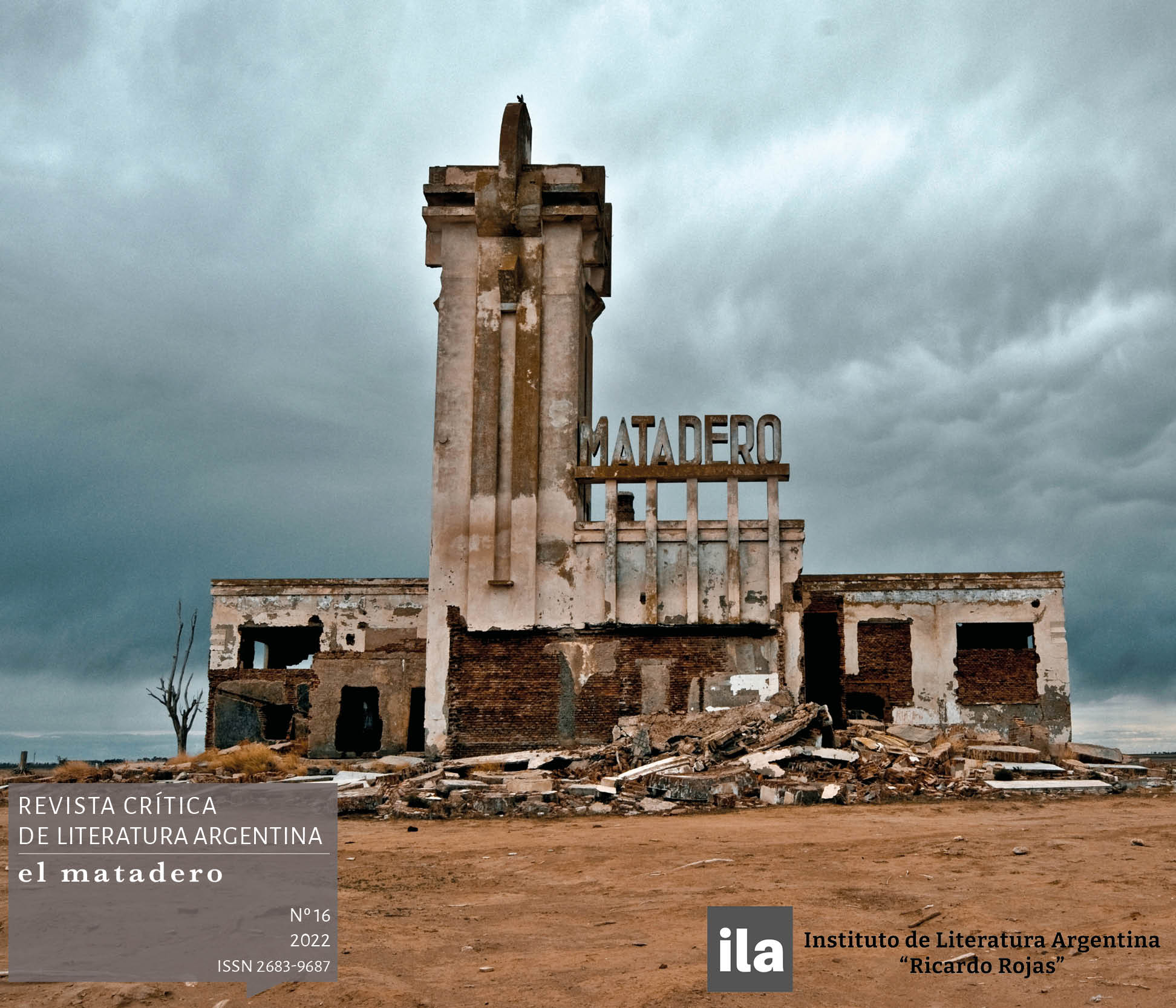¿Cuándo se escribió "El matadero"? Echeverría y la juventud perdida
Palabras clave:
El matadero, Echeverría, tiempo de la escritura, distancia, juventud
Resumen
Este artículo se divide en dos partes. En la primera se ocupa de establecer cuál sería la fecha estimada de escritura de “El matadero”. En contra de la hipótesis de la inmediatez, es decir de que Echeverría escribió este texto entre 1839 y 1840, poco antes de partir al exilio y muy cerca del momento en que transcurre la acción del relato, se sostiene la hipótesis de la distancia: a partir de ciertos datos presentes en el texto y en la prensa anti rosista de fines de la década de 1830 y comienzos de la siguiente, se puede argumentar que es muy probable que “El Matadero” haya sido escrito por Echeverría luego del comienzo del Sitio Grande de Montevideo (cuya fecha de inicio es el 16 de febrero de 1843). En la segunda parte, y teniendo en cuenta la hipótesis de la distancia, este artículo analiza la sintonía de “El matadero” con la Ojeada retrospectiva (que Echeverría publica en Montevideo en 1846) y el lugar clave que ocupa lo joven en esta encrucijada histórica y textual.Descargas
La descarga de datos todavía no está disponible.
Citas
Carilla, Emilio. 1993. “Juan María Gutiérrez y El matadero”. Thesaurus XLVIII: 30-68.
Echeverría, Esteban. 1874. “El matadero”, Obras completas. Escritos en prosa (con notas y explicaciones por Don Juan María Gutiérrez). Tomo Quinto. Buenos Aires: Carlos Casavalle Editor.
Echeverría, Esteban. 1940. Dogma socialista. Edición crítica y documentada, con un “Prólogo de Alberto Palcos”. La Plata: Universidad Nacional de La Plata.
Fontana, Patricio y Roman, Claudia. 2009. “De la experiencia de vida a la autoría en cuestión. Notas sobre las ficciones críticas en torno a ‘El matadero’”, Cuadernos del Sur-Letras 39: 127-144.
Halperín Donghi, Tulio. 2005. Una nación para el desierto argentino. Buenos Aires: Prometeo Libros.
Iglesia, Cristina. 2014. “Echeverría: la patria literaria”. En Una patria literaria. Historia crítica de la literatura argentina, vol. I, editado por Loreley El Jaber y Cristina Iglesia, colección dirigida por Noé Jitrik, 351-383. Buenos Aires: Emecé:
Molina, Hebe Beatriz. 2020. “En busca de la forma perfecta: El matadero y Amalia”. En Literaturas de la Argentina y sus fronteras: tensiones, disensos y convergencias editado por José Maristany, Mariano Oliveto, Daniel Pellegrino y Nilda Redondo. Buenos Aires: Teseo.
Pas, Hernan. 2020. “La invención literaria de Echeverría”. En E. Echeverría. El matadero; La cautiva, 7-35. Buenos Aires: Biblioteca del Congreso de la Nación. https://www.memoria.fahce.unlp.edu.ar/libros/pm.6006/pm.6006.pdf
Rocca, Pablo. 2012. “Una estela sarmientina: gauchos y soldados”. Muitas Vozes 1 (1): 83-99.
Scavino, Dardo. 2015. Las fuentes de la juventud. Generalogía de una devoción moderna. Buenos Aires: Eterna Cadencia.
Weinberg, Félix. 2006. Esteban Echeverría. Ideólogo de la segunda revolución. Buenos Aires: Taurus.
Echeverría, Esteban. 1874. “El matadero”, Obras completas. Escritos en prosa (con notas y explicaciones por Don Juan María Gutiérrez). Tomo Quinto. Buenos Aires: Carlos Casavalle Editor.
Echeverría, Esteban. 1940. Dogma socialista. Edición crítica y documentada, con un “Prólogo de Alberto Palcos”. La Plata: Universidad Nacional de La Plata.
Fontana, Patricio y Roman, Claudia. 2009. “De la experiencia de vida a la autoría en cuestión. Notas sobre las ficciones críticas en torno a ‘El matadero’”, Cuadernos del Sur-Letras 39: 127-144.
Halperín Donghi, Tulio. 2005. Una nación para el desierto argentino. Buenos Aires: Prometeo Libros.
Iglesia, Cristina. 2014. “Echeverría: la patria literaria”. En Una patria literaria. Historia crítica de la literatura argentina, vol. I, editado por Loreley El Jaber y Cristina Iglesia, colección dirigida por Noé Jitrik, 351-383. Buenos Aires: Emecé:
Molina, Hebe Beatriz. 2020. “En busca de la forma perfecta: El matadero y Amalia”. En Literaturas de la Argentina y sus fronteras: tensiones, disensos y convergencias editado por José Maristany, Mariano Oliveto, Daniel Pellegrino y Nilda Redondo. Buenos Aires: Teseo.
Pas, Hernan. 2020. “La invención literaria de Echeverría”. En E. Echeverría. El matadero; La cautiva, 7-35. Buenos Aires: Biblioteca del Congreso de la Nación. https://www.memoria.fahce.unlp.edu.ar/libros/pm.6006/pm.6006.pdf
Rocca, Pablo. 2012. “Una estela sarmientina: gauchos y soldados”. Muitas Vozes 1 (1): 83-99.
Scavino, Dardo. 2015. Las fuentes de la juventud. Generalogía de una devoción moderna. Buenos Aires: Eterna Cadencia.
Weinberg, Félix. 2006. Esteban Echeverría. Ideólogo de la segunda revolución. Buenos Aires: Taurus.
Publicado
2022-11-08
Cómo citar
Ansolabehere, P. (2022). ¿Cuándo se escribió "El matadero"? Echeverría y la juventud perdida. Revista Crítica De Literatura Argentina. El Matadero, (16). https://doi.org/10.34096/em.n16.13666
Número
Sección
Artículos








